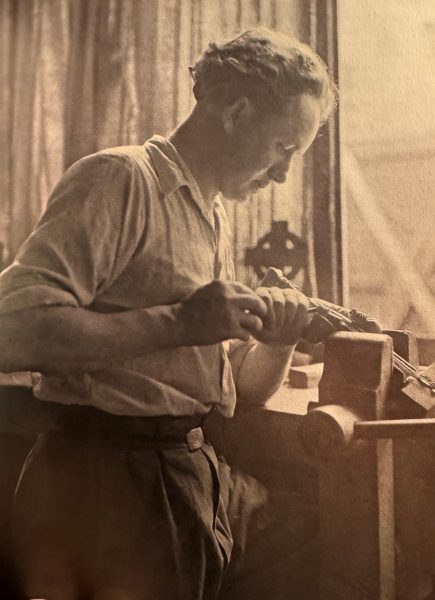MENU
Contact
Menu
Menu

(1901-1983)
Joseph Savina was born into a family of cabinetmakers in Douarnenez (Finistère). He continued his education with Jean Le Picard, a carpenter and sculptor.
He opened his own workshop, named “Atelier d’Art Celtique” on rue Saint-André in Tréguier (Côte d’Armor). There, he combined learning his craft with the new spirit of design, while remaining an ardent defender of Breton art. He rejected overly conventional decorative details, preferring to highlight the construction lines of his furniture. Described at the time as an “embroiderer on wood”, he produced numerous pieces of furniture. Savina was keen to offer a wide variety of decorative choices, which would gradually become the vocabulary of his creations: palmettes, volutes, lozenges, fish, interlacing kelp and more. Far removed from militant and political agitation, Joseph Savina’s artistic creations were an expression of his ambitions.
1935: Meeting with Le Corbusier
This meeting of ideas and personalities between the architect and Joseph Savina laid the foundations for a deep friendship that would last until Le Corbusier’s death in 1965. From the outset, Savina expressed his desire to approach contemporary design. Numerous letters testify to the genesis of their joint production, in which he asserts that “the plastic work is the basis of the architectural work”. He was passionately interested in the architectural innovations of Le Corbusier, whose architecture often resembled sculpture, and tried to parallel Le Corbusier’s principles with his vision of Breton art.
Le Corbusier, for his part, at nearly 60 years of age, embarked on the path of sculpture. He invited Savina to “pass from the decorative to true sculpture”, since for him “everything is sculpture”.
The Second World War did not put an end to their friendship; on the contrary, from 1940 onwards, they exchanged letters once again. It marked the beginning of their true creative partnership. In May 1943, Joseph Savina’s workshop reopened, and the cabinetmaker sent his friend some of his latest creations, to which the architect replied: “Courage Savina! You’re full of talent! I look forward to working with you!
1946: Prototype of the Ozon Opus sculpture
It was from a gouache sent to thank Le Corbusier for the supplies he provided in the post-war period that Joseph Savina thought of sculpting this work in wood. “As for Savina, I find it amazing, exceeding my expectations. Isn’t that good statuary? These lines – referring to the Ozon sculpture, Opus 1 – underline a true communion between the two men. The initials J.S – L.C appeared on the sculptures. This was the start of a series of polychrome sculptures, of which only two were large-scale. Savina, with the help of a Breton cabinetmaker, created the wood carvings, which were then corrected by Le Corbusier, who, once the form had been validated, took charge of the polychromy himself, not hesitating to go back to it if he wasn’t satisfied.
He died in 1983 in Tréguier.
Share
Works
© since 1980 Laffanour Galerie Downtown
18 rue de Seine, 75006 Paris
+33 1 46 33 82 41
Member of Compagnie Nationale des Experts
Member of Syndicat National des Antiquaires
Partner of the Museum of Decorative Arts
©2020 Laffanour Galerie Downtown
18 rue de Seine, 75006 Paris
+33 1 46 33 82 41
Member of Compagnie Nationale des Experts
Member of Syndicat National des Antiquaires
Partner of the Museum of Decorative Arts
Subscribe to the newsletter
To receive the Laffanour-Downtown Gallery newsletter, please use the contact form below.
Subscribe to the newsletter
To receive the Laffanour-Downtown Gallery newsletter, please use the contact form below.